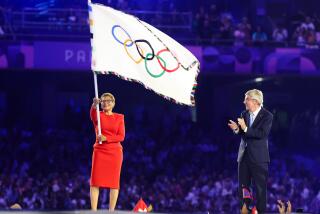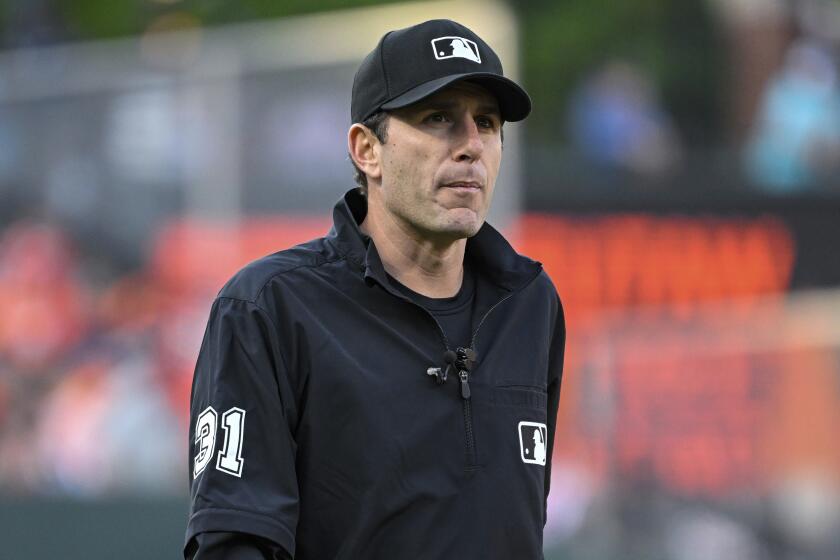Graying at the Temples
- Share via
They are both octogenarians now, and cranky ones at that. On a street corner in downtown Los Angeles, one continually complains about all the friends and relatives who have bailed out over the years. Alongside some bench seats in Pasadena, the other prattles on about being the “granddaddy of them all” and, dad gum it, you whippersnappers, isn’t that worth some respect?
The Coliseum turned 80 this month. The Rose Bowl is pushing 81. We mostly humor them now, nodding along as they try to convince everyone, including themselves, that each is just the place to house an NFL team, never mind the aging concrete, the outmoded architecture and the impudent upstart down the road in Carson.
The Coliseum and Rose Bowl both have representatives in Philadelphia today, preparing to make informal pitches to a league that abandoned the area in 1995 and is controlled by owners with the attention spans of sugar-addled 6-year-olds.
Show them shiny. Show them new. But two tradition-drenched buildings that not only predate John Madden and Thursday night football, but made their debuts in the early 1920s?
As the St. Louis Rams and Oakland (Again) Raiders and Houston Texans remind with every snap of the football, when it comes to this sort of thing, the NFL has a distinct edifice complex.
The Coliseum and the Rose Bowl have seen better days, lots of them, but just to pick one, how about 1959? Then, the Coliseum was home to Los Angeles’ four biggest sporting passions -- USC and UCLA football, the Rams and the just-arrived-from-Brooklyn, soon-to-be-crowned-World-Series-champion Dodgers.
The Rams were to Los Angeles what the Lakers are now -- the city’s glamour team, the first major league franchise to arrive on the West Coast. Owner Dan Reeves moved them from Cleveland in 1946, paving the way for the Dodgers’ arrival in 1958, turning the Coliseum into the nation’s largest big-league baseball park, with crowds of 90,000-plus cheering Wally Moon’s fabled “Moon Shots” over the Coliseum’s 251-foot left-field short porch.
At the same time, the Rose Bowl was flourishing as the preeminent temple of college football, with the University of Washington readying to end the Big Ten’s six-year winning streak in the New Year’s Day game.
Along with New York’s Yankee Stadium, Soldier Field in Chicago, Boston’s Fenway Park and few others, these were among the most important American sports facilities of the day. The Coliseum Commission knew it and flaunted it, publishing in 1959 a self-congratulatory volume that celebrated the greatness of the stadium’s past while casting a starry-eyed glimpse toward the future:
“In the days to come there is no shadow on the horizon to check the career of the Los Angeles Memorial Coliseum. ... The principle of supply and demand will govern, as it nearly always does. And athletics will continue to flourish, and will broaden their scope, as surely as the expanding population adds converts to their ranks.”
This, of course, failed to consider the impact of Georgia Frontiere and Al Davis’ someday being added to the ranks.
Another excerpt:
“It was written of Shakespeare, ‘He was not of an age, but for all time.’ This prophecy might well be argued for the Los Angeles Memorial Coliseum.”
Or maybe not.
The last two decades of the 20th century were hard ones for the Coliseum. In 1980-81, the stadium lost the Rams to Anaheim and UCLA to the Rose Bowl. In 1982, the Raiders came. In their 13 years in Los Angeles, the Raiders brought the Coliseum the fading luster of one Super Bowl championship -- and the everlasting “tough neighborhood” stigma that continues to scare the NFL into scouting the suburbs.
Today, the Coliseum is empty some 340 days a year. USC has remained faithful, its football team continuing as the stadium’s lone regular tenant. Throw in 10 to 15 soccer matches, a few rock concerts and a special event or two and in a good year the Coliseum might have 25 paydays.
The Rose Bowl continues as the home of UCLA football and the annual Big Game, which is no longer quite as big as it once was, diminished to preliminary status three years out of every four by the bowl championship series. And, in an ominous development that could set a tone for the NFL meetings in Philadelphia, the Galaxy abandoned the Rose Bowl after last season and will play its first home game in its new Carson stadium on June 7.
Depending on which bid the NFL favors, the Coliseum or the Rose Bowl -- or both -- could soon be teetering on the brink of obsolescence.
“That could very well be the case,” said Jim Hardy, former Coliseum general manager who played football in both stadiums as a quarterback for USC and the Rams during the 1940s and ‘50s.
“Certainly, if a new stadium is built, or they put the plunger to the Coliseum or the Rose Bowl and [preserve] a certain part of it as a historical monument and then build a new facility around it, it’s going to cause tremendous damage to the other facility. It stands to reason, because so many paydays would be taken away from the other building.
“I think the Coliseum would have a tougher time than the Rose Bowl because the Rose Bowl does have the annual Rose Bowl game and with that and the Tournament of Roses, the city of Pasadena is able to turn that into a monumental success every year. But if a pro team went into the Rose Bowl, boy, it would really hurt the Coliseum.”
Pat Lynch, general manager of the Coliseum, believes the most serious threat to either the Coliseum or the Rose Bowl is the potential for a Carson stadium.
“If we’re able to get the deal done with the NFL,” Lynch said, “then UCLA stays [at the Rose Bowl], the Rose Bowl game stays, everything is just fine. You look at [the Rose Bowl’s] financial statements for the last several years and they’re doing just fine up there.
“What they’re nervous about is a third-site stadium. Now that would concern me too. The last time when a downtown-site [proposal] came about, I made a comment that [if] you build one new stadium, you kill two. That’s much more applicable.... It wouldn’t be good. It wouldn’t be good for either of us.”
Lynch believes both the Coliseum and Rose Bowl can survive provided they don’t lose their college football tenants and a new facility doesn’t siphon off the special events the older buildings now schedule.
“If the Rose Bowl were to get the [NFL] team, USC’s not going there,” he said. “Those two college teams will not mix, I don’t think.... When you have your major tenant hanging with you, you can stay alive.
“Now, can you improve and do all the bells and whistles? You’ve got to be very judicious as to how you spend your funds. But you won’t die. You won’t be obsolete.”
Oakland Tribune sports columnist Art Spander grew up in Los Angeles in the 1940s and ‘50s, selling programs as a kid in both stadiums, which enabled him to witness the 1954 Rose Bowl game. Spander hasn’t missed one since, extending his streak to 50 in January.
Cast against today’s multi-decked, private suite-heavy NFL standard, the vast single-tiered bowls of the Coliseum and Rose Bowl are already obsolete, according to Spander.
“It wasn’t until I got into this business and started traveling [that] I realized how far away you are from the action in the press box of the Coliseum,” Spander said. “I didn’t understand why they double-deck stadiums. Well, now I do. Because you’re much closer to the field.
“But the Coliseum keeps going up and out. And when you’re far up, you’re also far back.... The concourse tunnels are really long. I get claustrophobia sometimes. You’d get trapped in them after an SC-UCLA game and all the fans are coming out but nobody’s moving.”
Spander likens the Coliseum and the Rose Bowl to Pauley Pavilion, which opened in 1965 and was long considered a pristine palace of college basketball.
“Look at Staples Center,” he said. “Compared to that, Pauley is now outmoded, outdated. Even Dodger Stadium -- I was there for the first game, ‘62, and boy, it was like the end of the world. And now you compare it to Pac Bell, or to [the ballparks in] Cleveland or Colorado. It’s just like comparing a 1964 car with a 1994 car.
“We have advanced so much in our thinking, architecturally and everything. You can’t take either the Coliseum or the Rose Bowl and try to compare it with those stadiums in Houston or Carolina. They’re just so different.”
Sportscaster Keith Jackson, a longtime Southland resident, has called dozens of games in both the Coliseum and the Rose Bowl and would like to see an NFL team playing its home games at the Coliseum -- but only if the price is right.
“I’m a Coliseum man, myself,” he said. “Always have been. To me, the Los Angeles Coliseum is the logical place. If you’re going to have a pro football franchise, I think that site is the best.
“There’s the history of it. You talk about historic national monuments in sports, my goodness. I know the Rose Bowl is famous and all of that, but still, it’s the Coliseum where the history of pro football exists. And you have the Moon Shots and the Olympics and all of those things.
“And it’s a municipal center, if you will, adjacent to the downtown area. They keep talking about a ‘downtown location.’ Well, that’s pretty close.”
However, Jackson said he doesn’t believe “it’s incumbent on taxpayers and communities to subsidize sports franchises.” He said the outcry for the NFL’s return to Los Angeles “doesn’t impress me. I don’t need somebody from New York telling me how important it is.
“I live here. I’ve been here since 1964. I’ve seen this guy come and that guy go. And the city’s still here. I don’t think we need a whole hell of a lot more publicity, do we? We’re not going to go away.”
Professional football “had a long run” in Los Angeles, Jackson said. Maybe long enough.
“You know, some things were meant to go away,” he said. “It’s like these environmentalists who keep wanting to shut down the logging industry for the spotted owl. Some creatures weren’t meant to last forever.”
More to Read
Go beyond the scoreboard
Get the latest on L.A.'s teams in the daily Sports Report newsletter.
You may occasionally receive promotional content from the Los Angeles Times.










